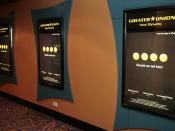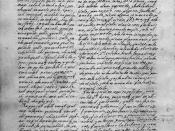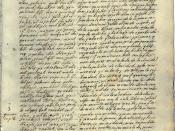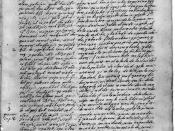Popol Vuh "The Mayan Creation" Popol Vuh was an integral part of the Mesoamerican society that had been enlightened with the western biblical judiciousness. The Mesoamericans, which were called Quiché people, believed that their Ancient World was fashioned from the same matter and aspects as that of the Western Judeo Civilizations. There are numerous transactional meanings between the biblical stance and the creation story of the Quiché. Many narratives have been borrowed from the bible and reconstituted back into the five stories of the Quiché demonstrating that their belief system was greatly influenced by an outside source. In Dennis Tedlock's translation of the Popol Vuh, the connection between Christian theology and Mayan civilization is clearly seen with inferences between both religious testimonials lumped into one general religious idea.
The Creation of the Quiché people is an elegant but ambiguous piece of writing. The storyteller and later the scribe, was influenced by an outside source of information as can be seen within the prologue of the Creation story.
The prologue of the Popol Vuh focuses on the naming of those that exist in the world and the actions of the gods: And here we shall take up the demonstration, revelation, and account of how things were put in shadow and brought to light by the Maker, Modeler, named Bearer, Begetter, Hunahpu Possum, Hunahpu Coyote, Great White Peccary, Tapir, Sovereign Plumed Serpent, Heart of the Lake, Heart of the Sea, Maker of the Blue-Green Plate, Maker of the Blue-Green Bowl, as they are called, also named, also described as the midwife, matchmaker named Xpiyacoc, Xmucane, defender, protector, twice a midwife, twice a matchmaker, as is said in the words of the Quiche. (Norton 1746; Popol Vuh) This long narrative, describes, in many forms, the god or maker of the Quiché people. The Quiché showed an enormous amount of latitude in the naming of their god because of the culture's religious rituals. Within this religious text, a western style of meaning is seen within the many different names of the gods. This could have been possible if the Quiché's religious beliefs were corrupted by outside cultures that brought those beliefs to the Quiche and tried to conform them to the western way of believing in god.
The Quiché Creation story tells how the land was before any living organism inhabited the earth. For the Quiché people, "the world had no animals, birds, fish, crab, tree, rock, hollow, canyon, meadow, [or] forest" (Norton 1747; Popul Vuh). The Quiché are much more descriptive in their analogies than that of the people in the Old Testaments on how the earth was formed. The storyteller tells of gods forming their own part of the earth and having great agreement and disagreement over what should be placed on the earth.
The Quiché had a between order god; thus there is a god of the people and there is a god of the gods. This system allow the king or leader of the Quiché to talk to their god who then in turn talk to the highest, supreme or most elevated god. The Quiché had a tier system within the structure of the gods. This is symbolic in the way the people structured their leadership and built their pyramid structures; the religious writing of the Creation story has been easily influenced by the western civilization in the way angels were presented to people and then these angels would talk to god for them. There is a sense that the western biblical ministry plagued the creation section of the Popol Vuh.
The prologue of the creation has shown a great misinterpretation of the true beliefs of the Mayan people. The Quiché religion has been modified and assimilated into the Western Biblical Christian religion instead of the more ritualistic civilization that gave sacrifices to many gods.
In part, three of the Popol Vuh (Victory over the Underworld), Tedlock shows another representation of western influence in the way religious beliefs were told in the story. Instead of an Adam and Eve, the Quiché had two young boys named One and Seven Hunahph, which represented the order of the people. In the passage, these two young boys entered the Dark House and are given two tests by a certain god named One and Seven Death inorder to see if they can be tempted by worldly postions. The tests dealt with temptation and overcoming one's fear. Unfortunately, One and Seven Hunahph could not resist their temptations and were beheaded for their deeds.
One Hunahph's head is placed in the fork of a Calabash tree and his body is buried with his brothers. This Calabash tree bore no fruit until the head of One Hunahph is inserted in its branches, and produced an abundant amount of fruit. This clearly is representative of the Garden of Eden, when God told Adam and Eve not to eat from the Tree of Knowledge, and the immaculate conception of Mary when Jesus was born. The Blood Women is being depicted as that in the same as Eve. Blood Women's father told her not to eat from the Calabash tree for it had the head of One Hunaphu in it and it looked just like the fruit that was born onto the tree. At the Calabash tree, the head of One Hunaphu tempted the Blood Women by telling her, "she does not want merely a bone [piece of fruit] of the tree" (Norton 1752; Popol Vuh). Through the persuasive language of One Hunaphu, the Blood Women reached for the piece of fruit but instead of receiving the fruit, "One Hunaphu spit into the palm of the woman's hand" (Norton 1752; Popol Vuh). The women received, not only wisdom from the tree, but also received the gift of child to be born in likeness of One and Seven Hunaphu. This passage is symbolic of a Western Judeo religious enlightenment on the scribe of the Mayan writer. There are many references between the story of Adam and Eve and the immaculate conception of Mary.
The story has been enriched with the western religious beliefs to give meaning to what the Mayan people should have thought to make sense of life before the Quiché people knew of it. There is no real meaning of how the Quiché people came to be, there is only borrowed subtext and inferences from a religious standpoint of the western style of Judeo Christianity.
In the second section of the Victory of the Underworld, the sons of the Blood Women, kill One and Seven Death and lead their whole following into the abyss of the canyon for eternity. Hunaphu and Xbalangue, which were the sons of the Blood Women and the sons of One and Seven Hunaphu, tricked One and Seven Death into a game of betrayal and deceit. The two boys sought revenge for their fathers' death. The boys Deceived One and Seven death by acknowledging that they could sacrifice a living animal or human and bring it back to life. After One and Seven Death sees this, they want to be sacrificed and brought back to life too. Then after one of the lords had been sacrificed, and the other lord sees that he boys have no intentions to bring the other god back to life, he says to them, "take pity on me" (Norton 1775; Popol Vuh) for he did not want to die as the other god done. Also within the narrative, the god sees his vassals go to the canyon and enter the abyss for eternity. This is a great piece of Judeo Christian script when the heavens erupt into war between Satin and God. After Satin waged his battle and lost, he and his followers were cast into the fiery pits of the earth to live out their lives in the underworld.
There are great parallelisms between Western Judeo Christianity and the Mayans interpretations of how the creation of the world. The missionaries that came to the Mayan civilization influenced the scribe of the Popol Vuh to incorporate a Christian theme to the text. Without the Christian influences, the writings or story telling might be much different from that of Tedlocks translations. The ancient story is versed through oral presentations before being written or put into pictographic symbols. Through these missionaries, many true meanings have been lost due to missionaries proselytizing, in which they reshaped all other civilization into the Judeo Christian mold. The Mayan civilization differed greatly in the approach to the way they perceived the world unfolding. These are two different extremes meshed into one symbolic notation of how the world was formed.
Works Cited ___________________________________________ The Norton Anthology of World Masterpieces. Gen. ed. Maynard Mack. Expanded ed. in 1 vol. New York: Norton 1997.
![[Portrait of Abe Most, Pete Ponti, Sid Jacobs, and Jimmy Norton, Hickory House, New York, N.Y., ca. June 1947] (LOC)](https://s.writework.com/uploads/9/94582/portrait-abe-most-pete-ponti-sid-jacobs-and-jimmy-norton-hi-thumb.jpg)




